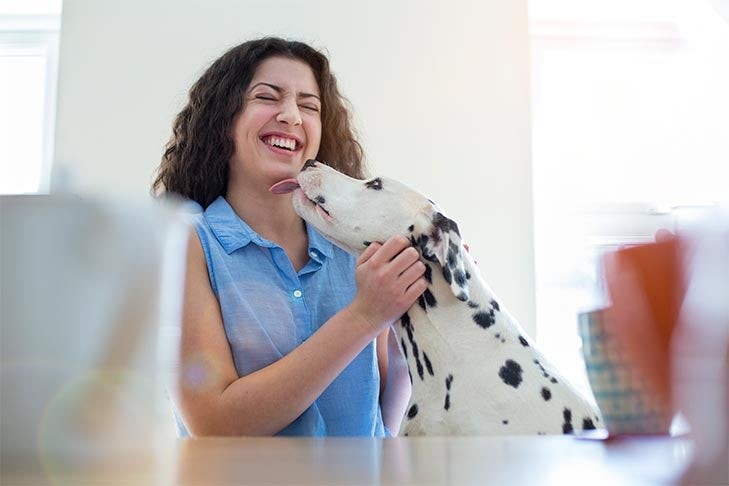Coming home to a dog enthusiastically licking your face is a common experience for dog owners. While often interpreted as a sign of affection, the reasons behind a dog’s licking behavior are more complex than a simple “doggy kiss.” So, why does your dog lick you, and when should you be concerned?
Decoding Dog Licks: It’s Not Always About Kisses
Contrary to popular belief, a dog’s lick might not be their version of a kiss. Dr. Alexandra Horowitz, director of the Horowitz Dog Cognition Lab at Barnard College, explains that licking in canids originated as a food-seeking behavior. Puppies lick their mothers’ mouths to stimulate regurgitation, a way for the mother to provide pre-digested food.
Your dog might also be licking you because you simply taste good! Human skin, especially after sweating, has a salty taste that dogs find appealing. Dr. Mary Burch, a certified applied animal behaviorist, points out this salt-seeking behavior as a potential reason for those enthusiastic licks. Dr. Horowitz adds that your dog might be particularly drawn to your face after you’ve eaten something tasty.
Licking as a Sign of Affection and More
While rooted in survival instincts, licking has evolved in dogs. It’s become a ritualized greeting, similar to how some wild canids lick pack members as a welcome home gesture. So, those slobbery greetings could indeed be your dog’s way of expressing joy at seeing you.
Dr. Burch confirms that licking can signify affection, providing dogs with a sense of security and comfort reminiscent of being licked by their mother as puppies. However, excessive licking can indicate underlying issues like anxiety, boredom, or even pain. It’s crucial to differentiate between normal licking and problematic behavior.
When Licking Becomes a Problem: Recognizing the Signs
Most dog licking is harmless, a form of canine communication and self-expression. Dr. Burch clarifies that licking is a submissive behavior, not an attempt at dominance. However, excessive licking of themselves, you, or objects can be a red flag.
If your dog’s licking seems compulsive or self-soothing, it could indicate underlying anxiety, boredom, pain, allergies, or other health issues. Consult your veterinarian to rule out medical causes before addressing potential behavioral problems.
Addressing Problem Licking: Redirection and Positive Reinforcement
If your veterinarian has ruled out medical reasons for excessive licking, focus on behavioral solutions. Dr. Burch suggests redirecting your dog’s attention when they start licking excessively. Introduce an incompatible activity, such as using a puzzle toy to get a treat, playing fetch, or engaging in trick training.
Lick mats can also provide a safe and positive outlet for your dog’s licking urge. Spreading dog-safe peanut butter or yogurt on a lick mat can satisfy their need to lick without causing harm.
Turning Licking into Learning: Trick Training and Engagement
Transform unwanted licking into an opportunity for positive reinforcement through trick training. Start with a simple command like “sit,” rewarding the behavior with a treat. Gradually introduce more complex tricks like giving hugs, speaking on cue, sitting up, or leg weaving.
Trick training not only redirects unwanted behavior but also provides mental stimulation and strengthens the bond between you and your dog. Consider participating in AKC Trick Dog trials if you and your dog enjoy this activity. Remember, a tired and engaged dog is less likely to engage in excessive licking. Ensure your dog receives ample exercise and attention to prevent boredom and promote overall well-being.

